
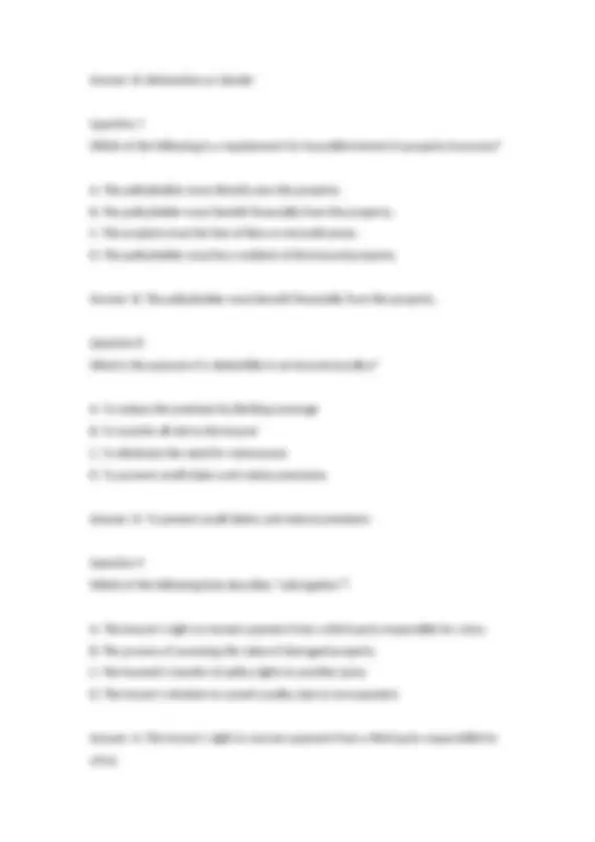
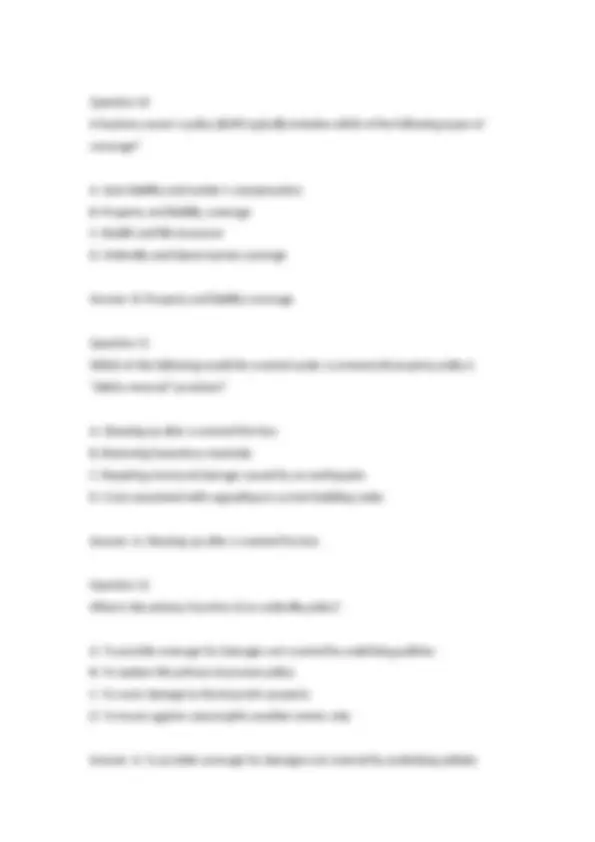
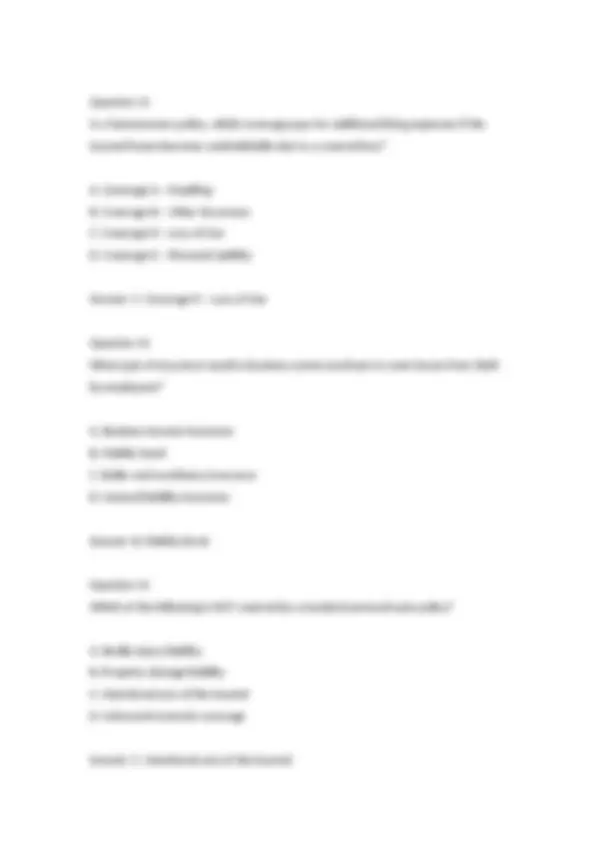
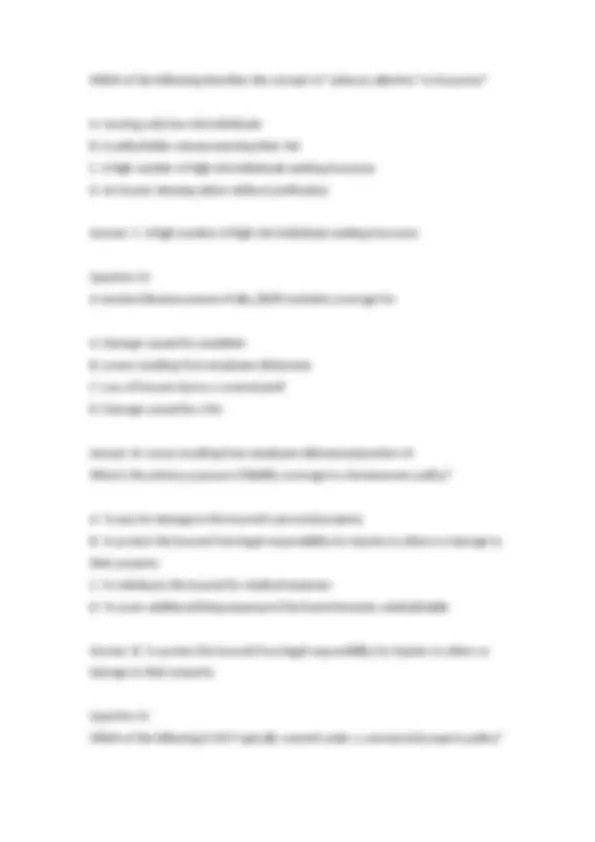
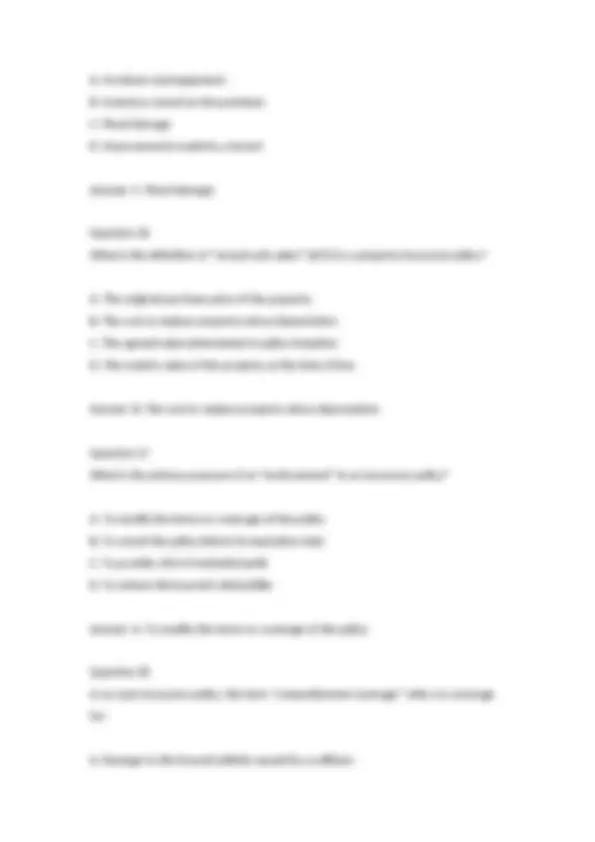
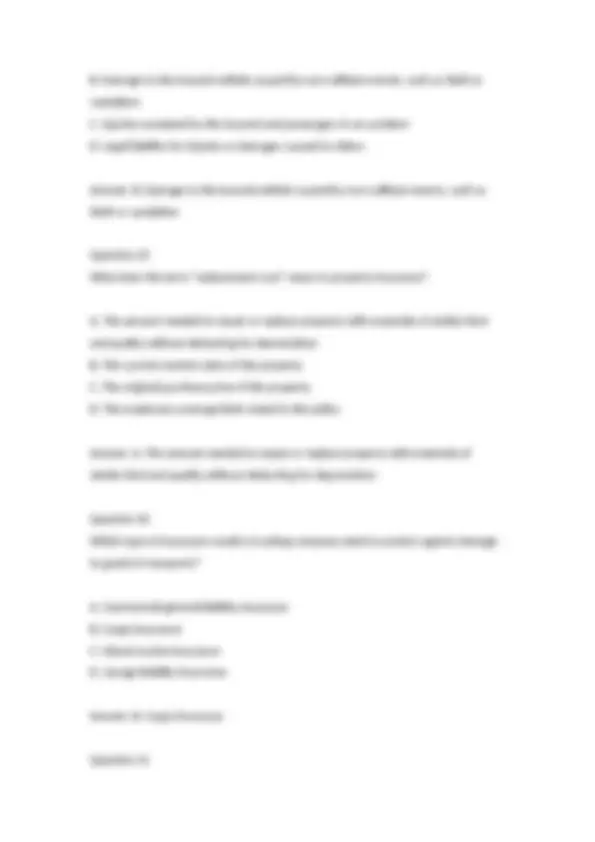
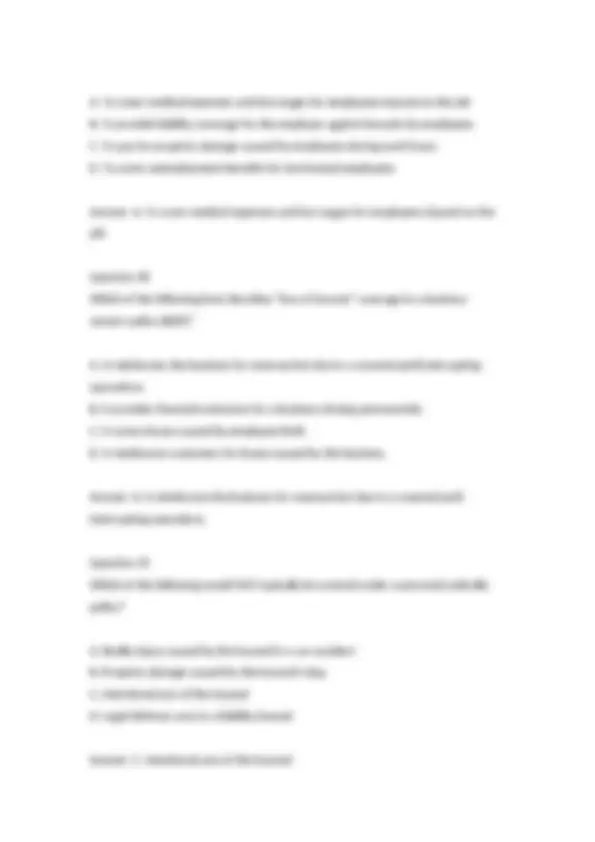
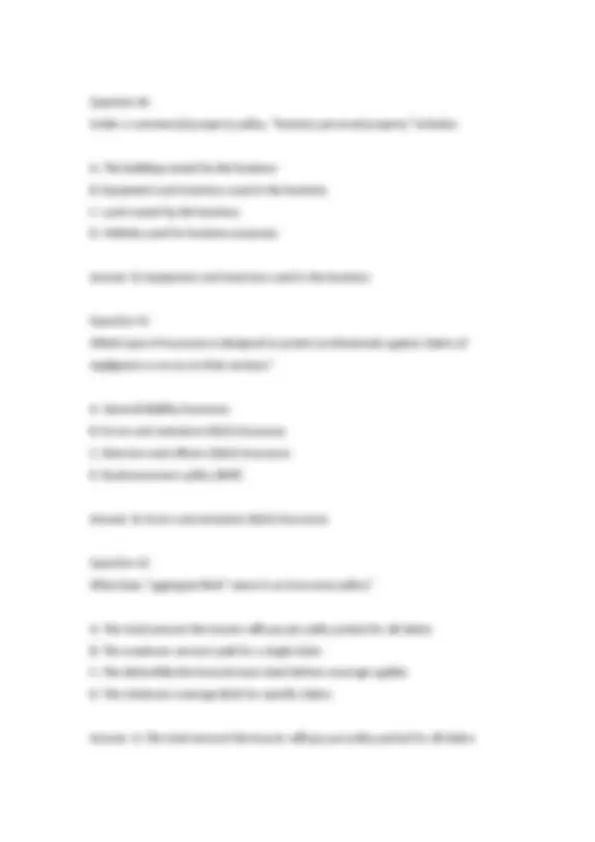
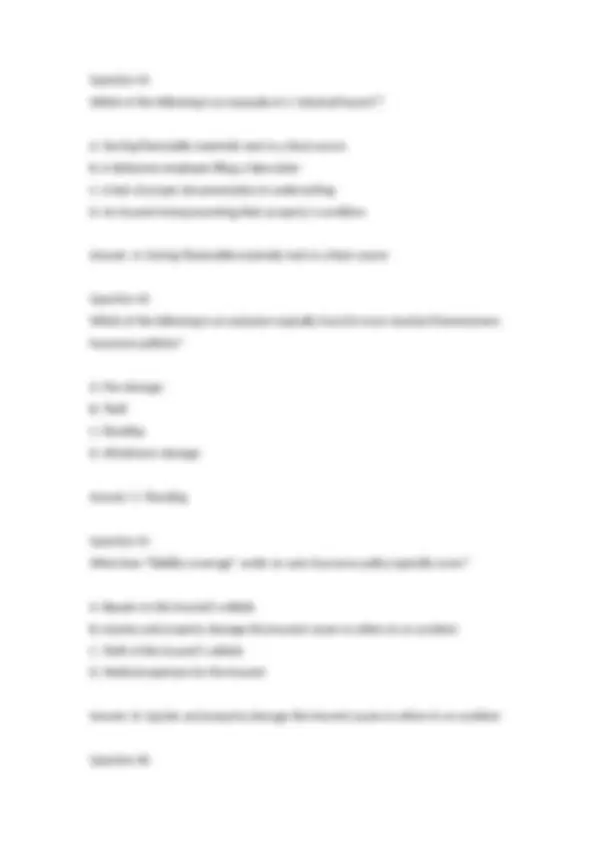

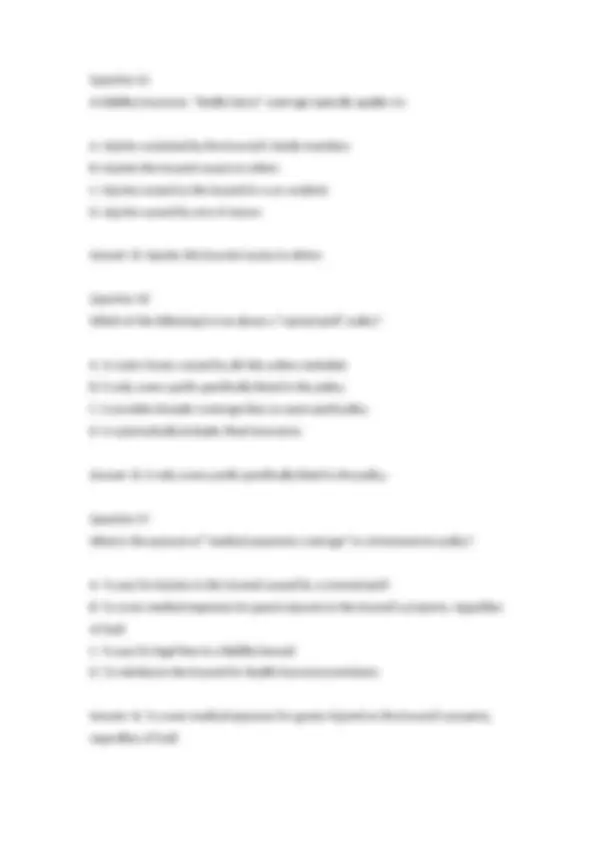
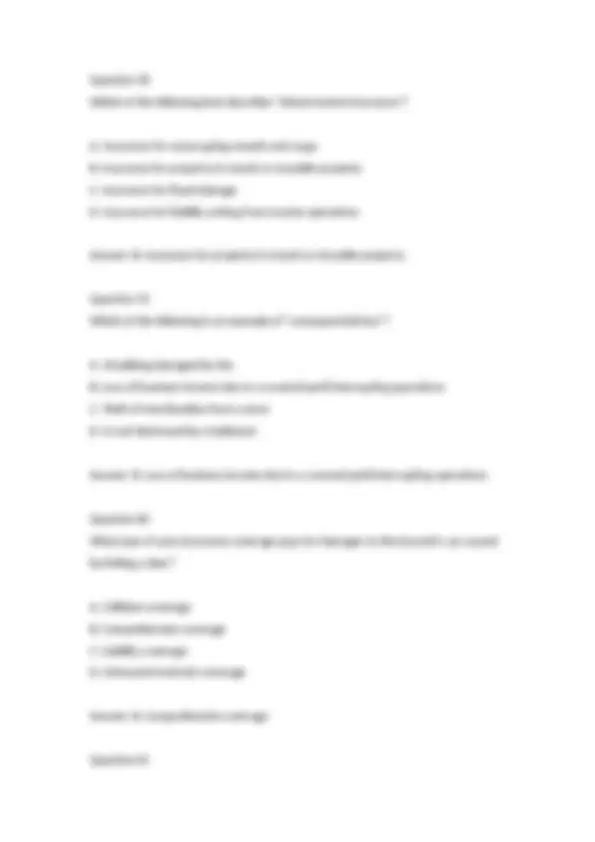
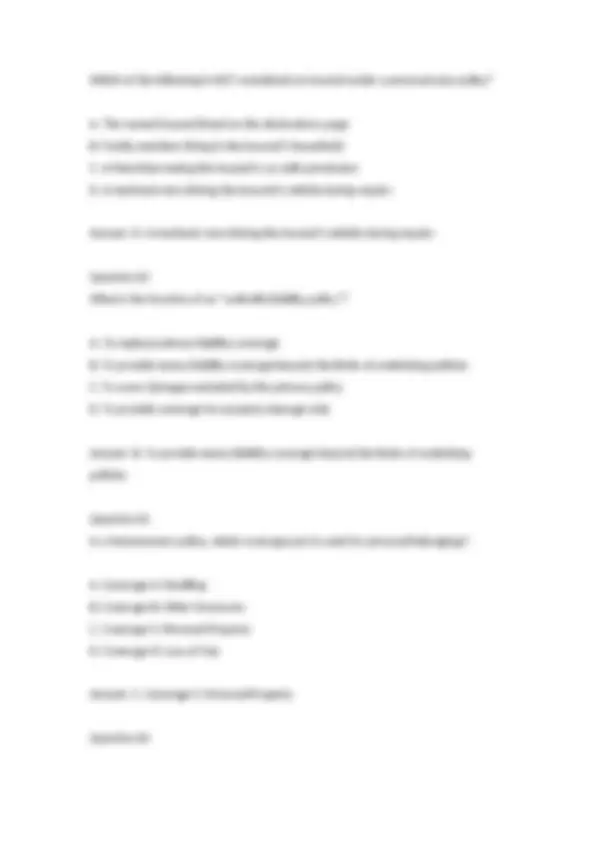
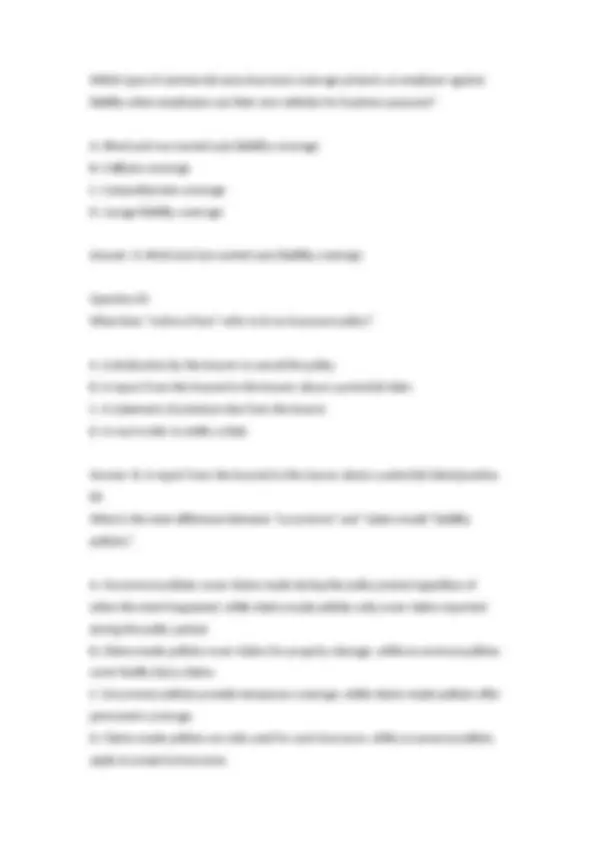
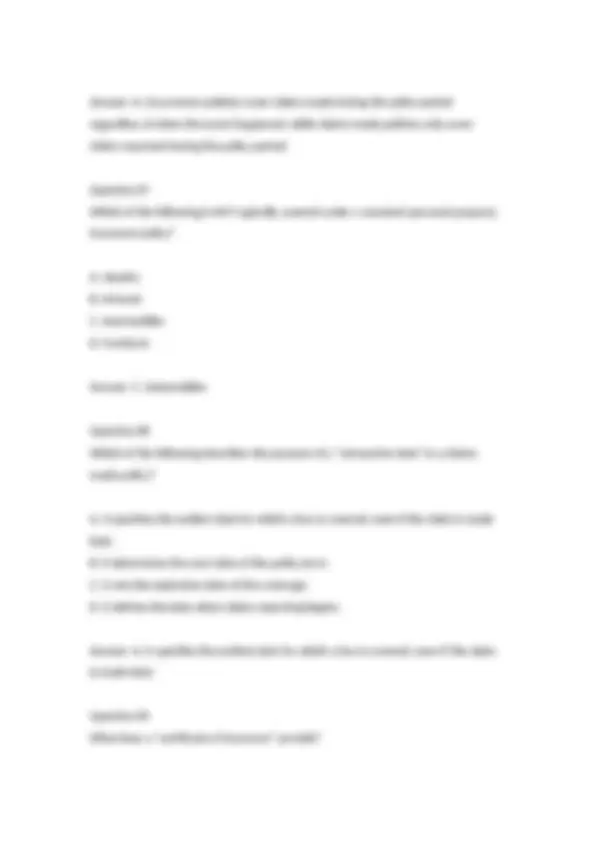
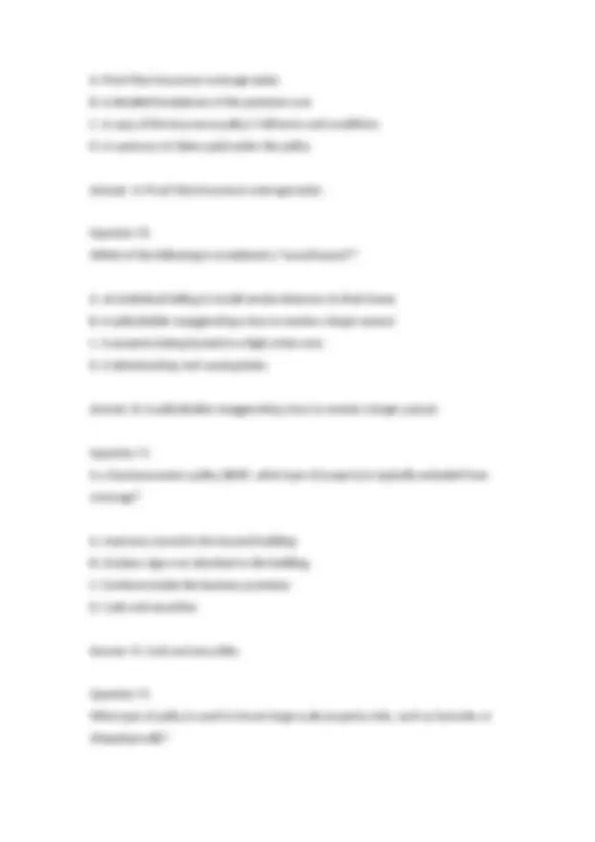
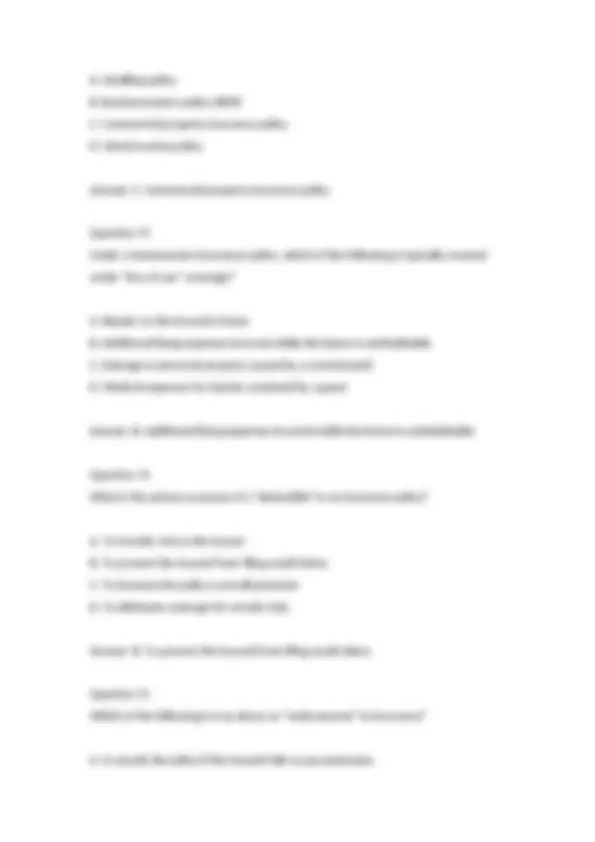
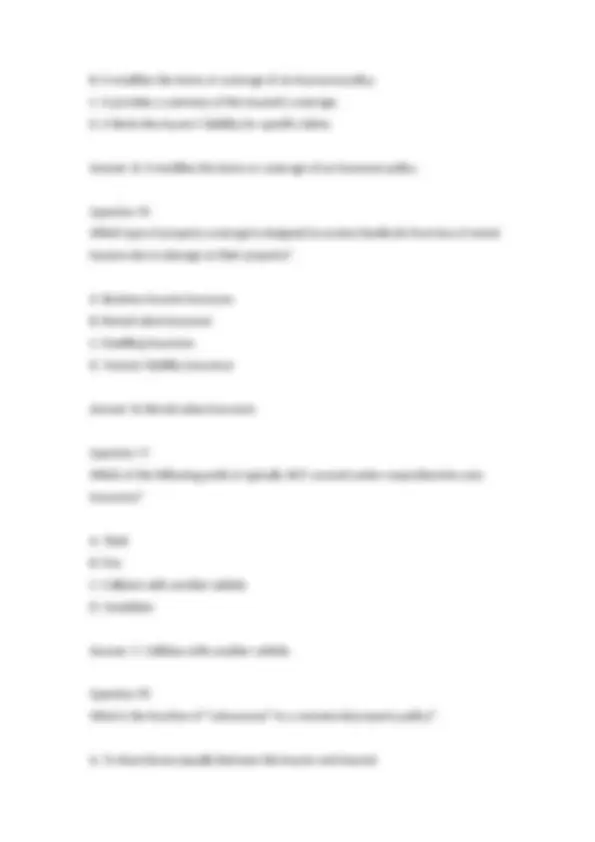
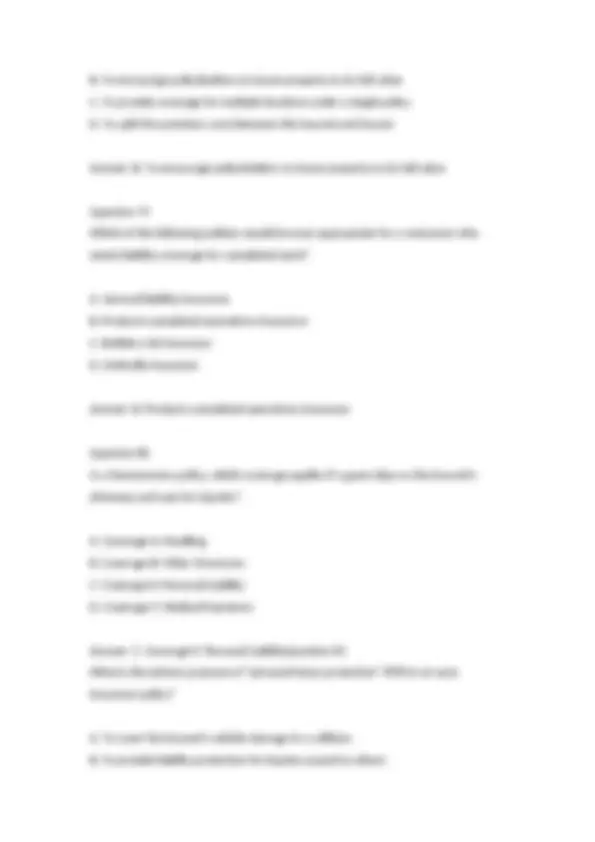
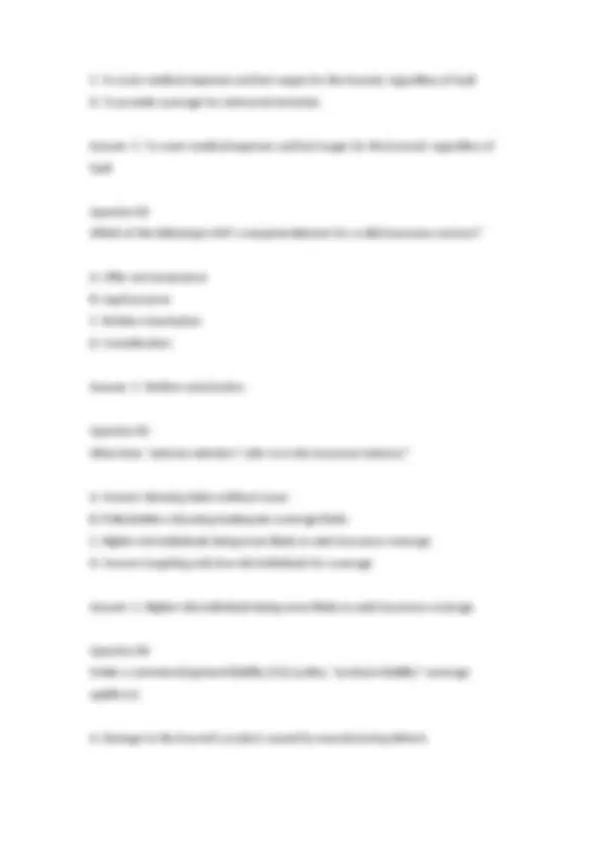
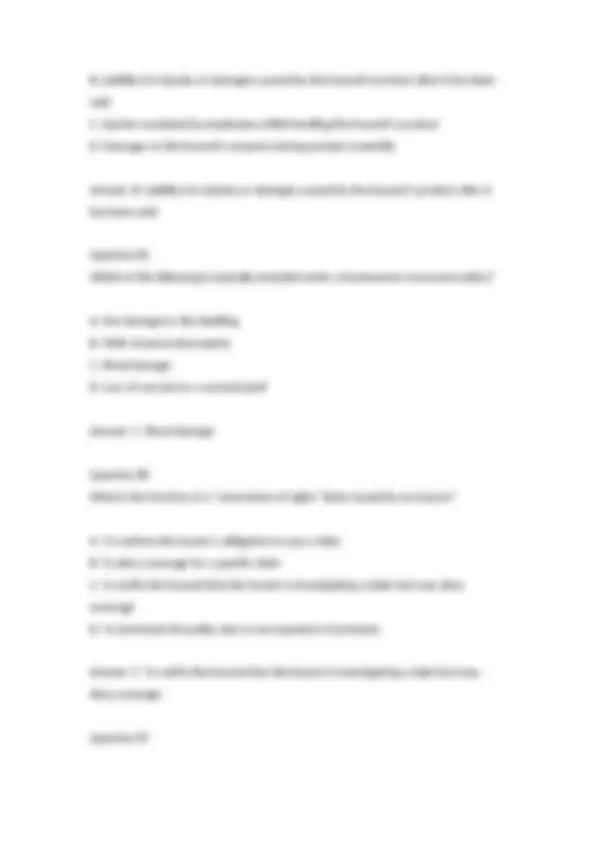
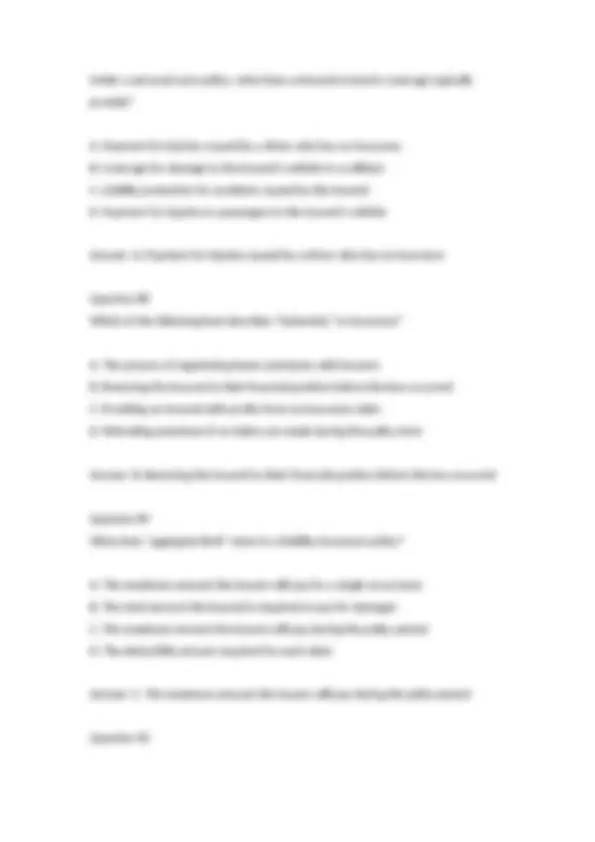
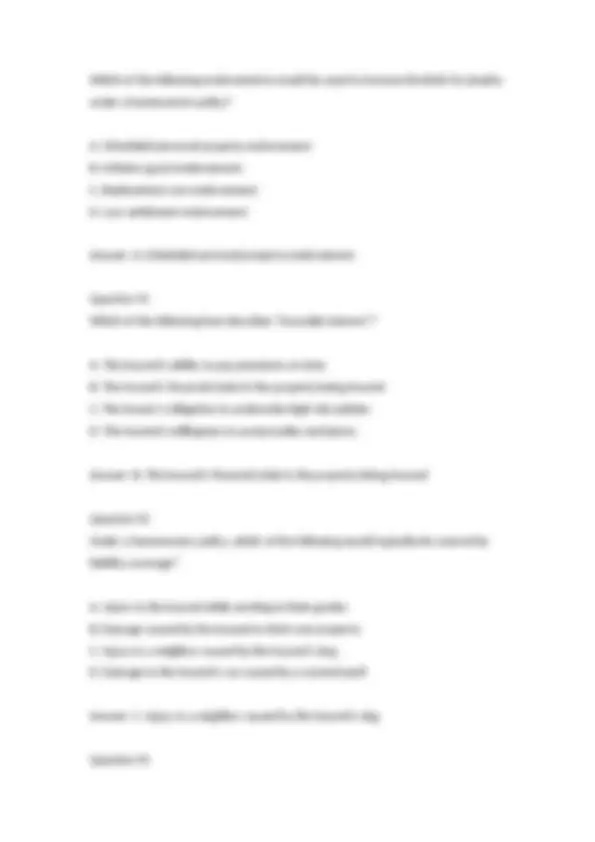
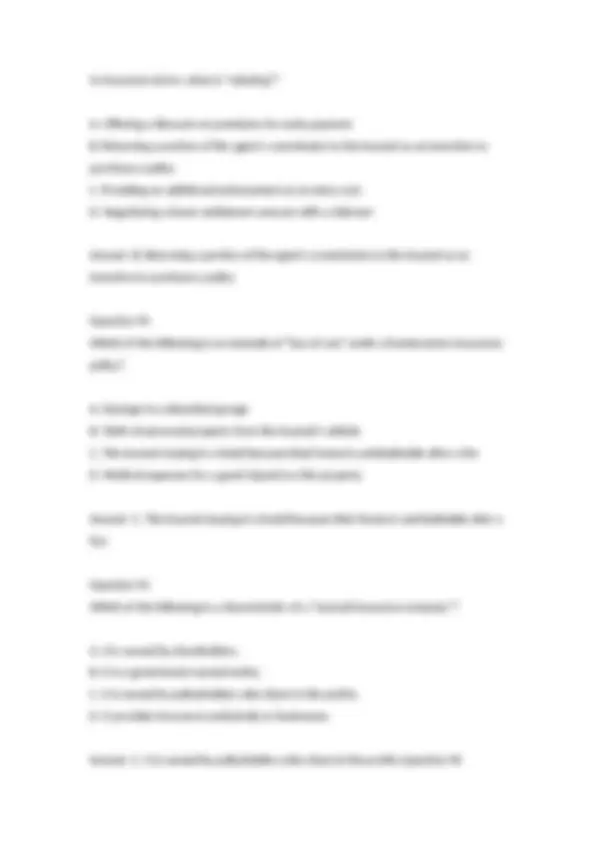
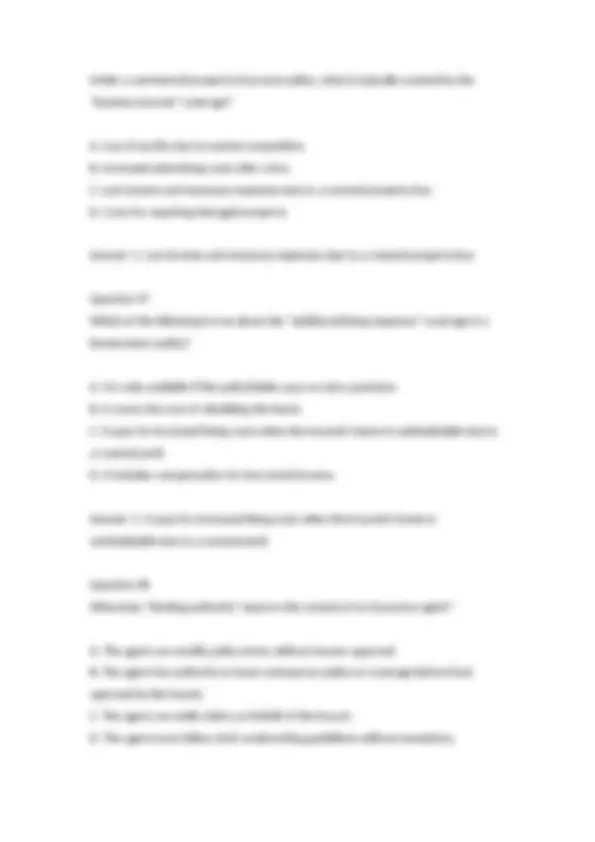
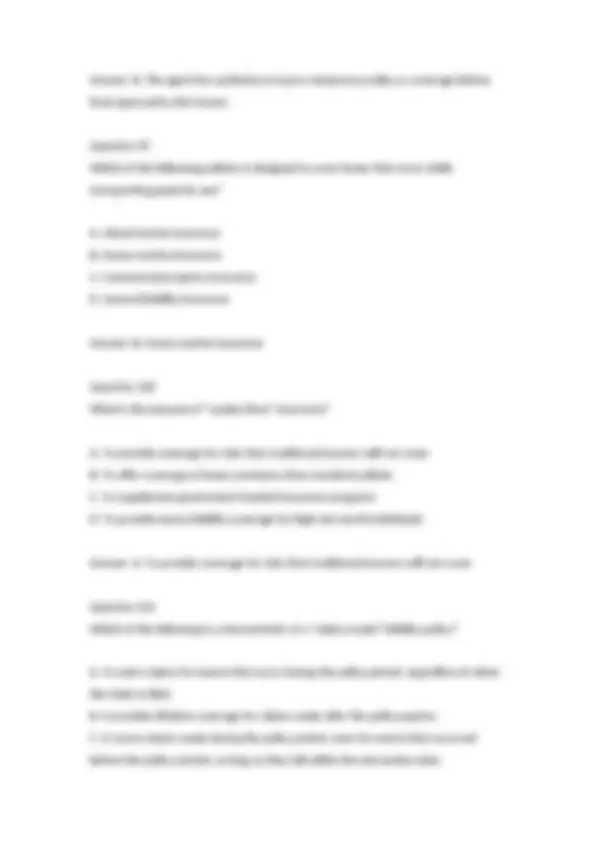
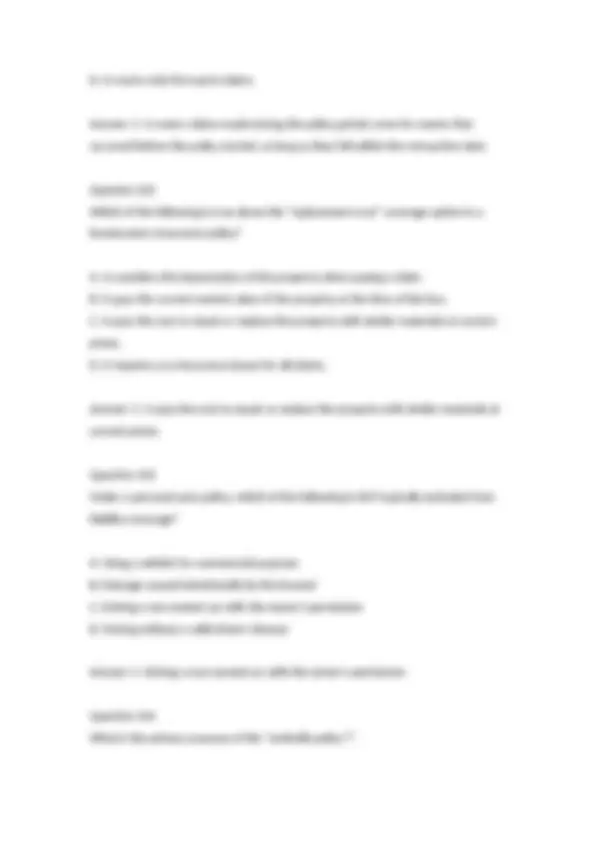
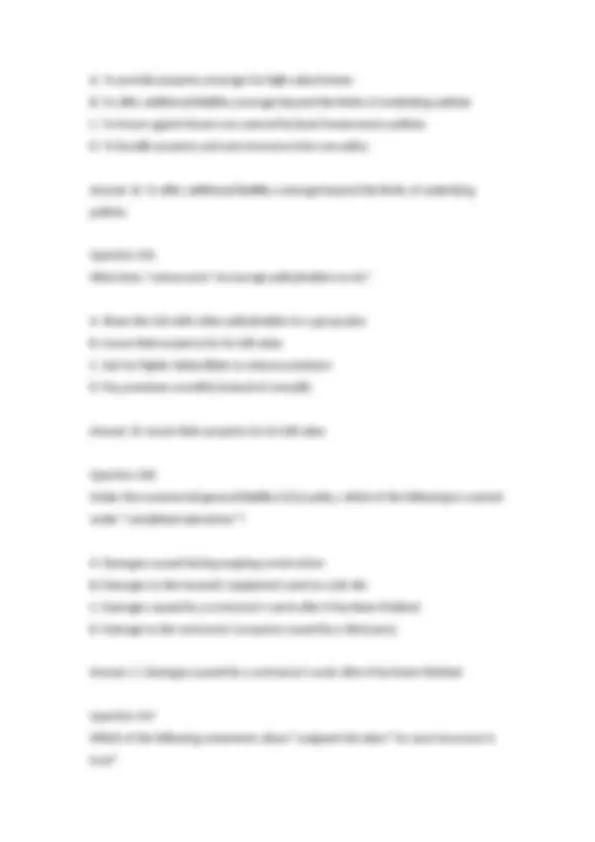
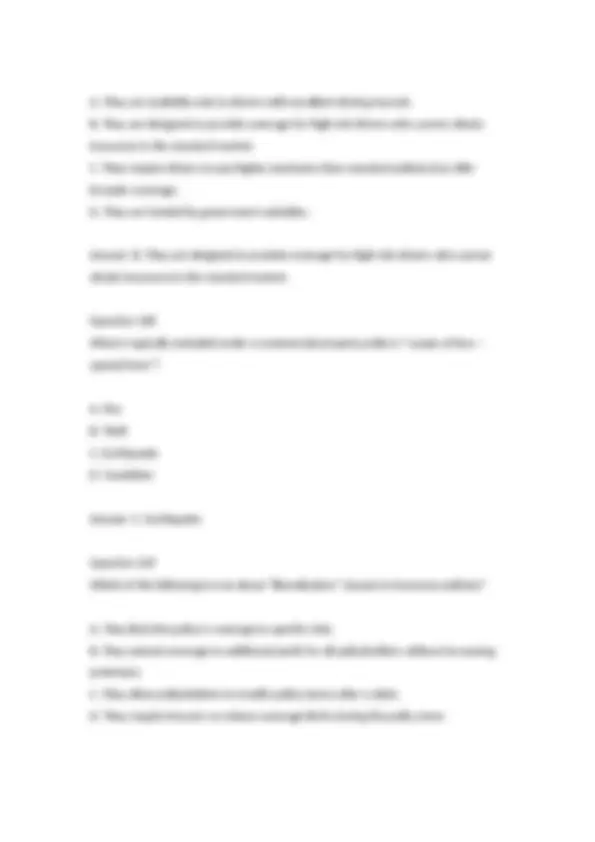
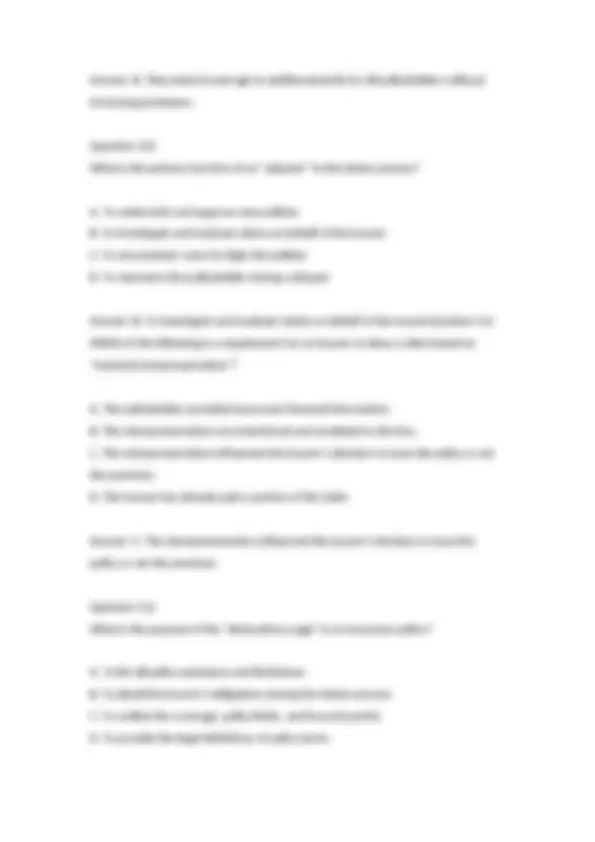
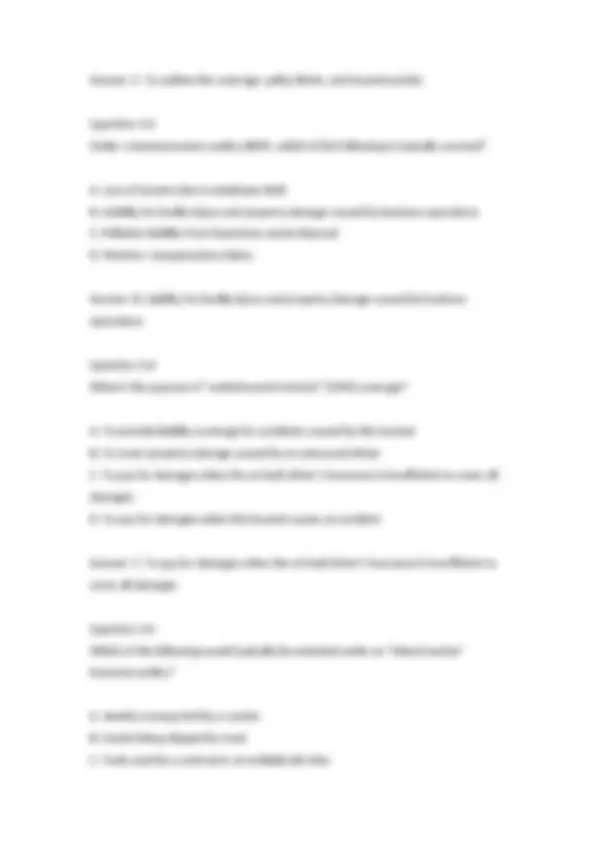
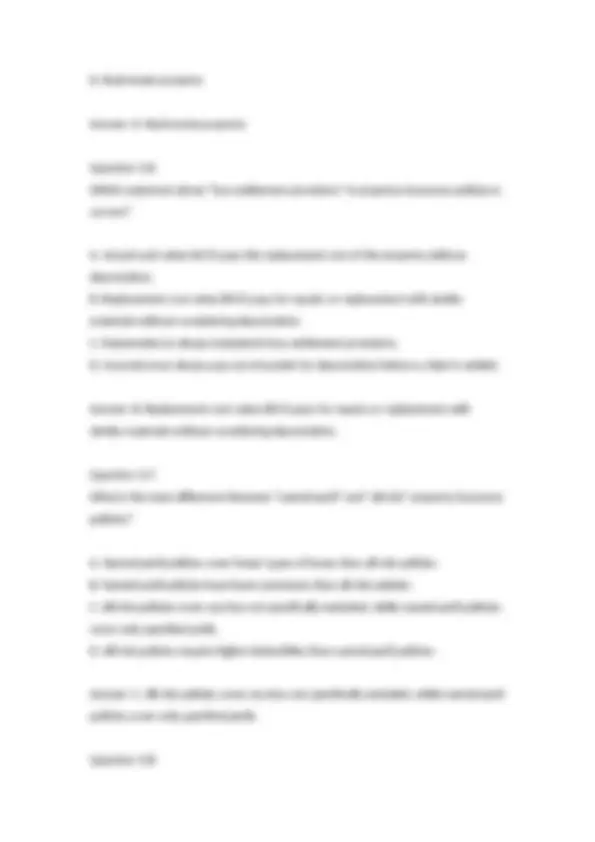
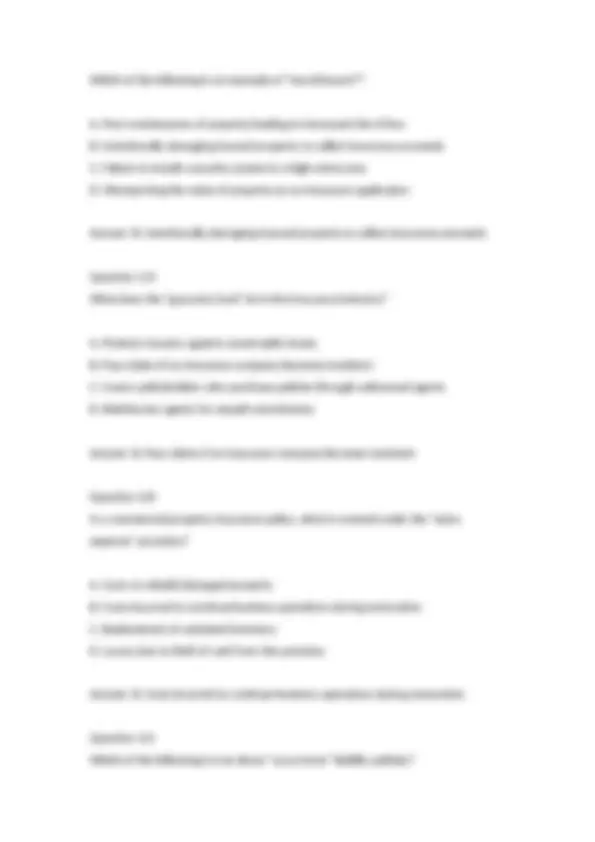
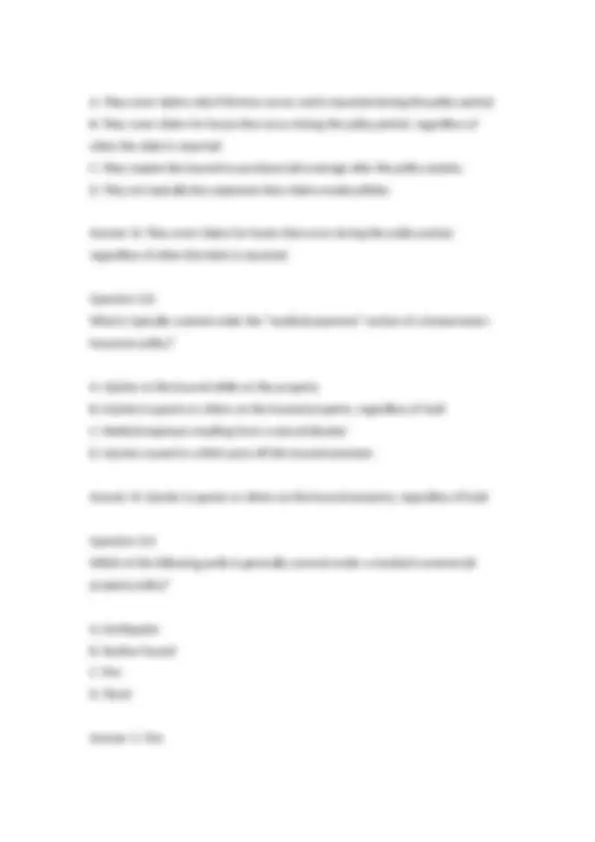
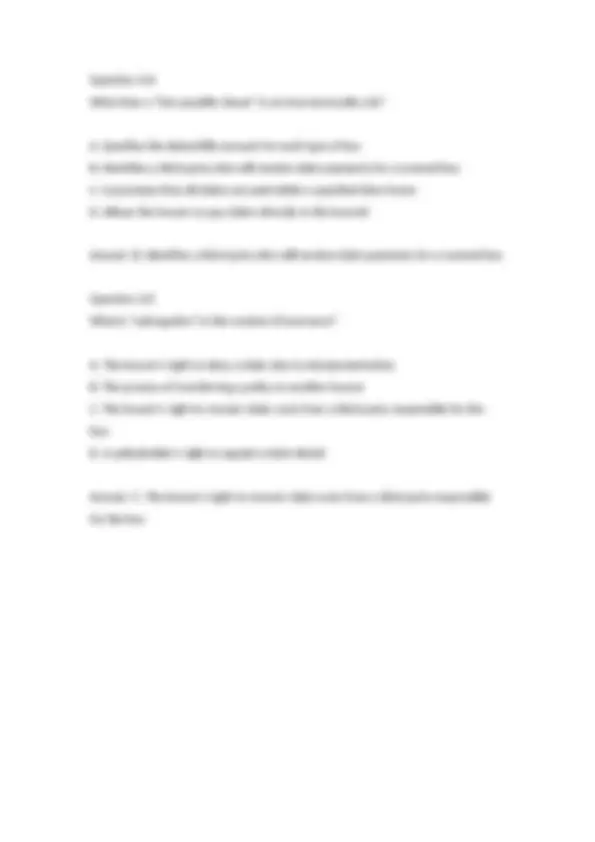


Study with the several resources on Docsity

Earn points by helping other students or get them with a premium plan


Prepare for your exams
Study with the several resources on Docsity

Earn points to download
Earn points by helping other students or get them with a premium plan
Community
Ask the community for help and clear up your study doubts
Discover the best universities in your country according to Docsity users
Free resources
Download our free guides on studying techniques, anxiety management strategies, and thesis advice from Docsity tutors
Summary Property & Casualty Insurance License Test Updated 2024/2025 > Pass the P&C Insurance Licensing Exam With Flying Colors.
Typology: Exams
1 / 43

This page cannot be seen from the preview
Don't miss anything!




































Question 1 Which of the following is an example of a peril covered under a standard homeowners insurance policy? A. Wear and tear B. Fire C. Neglect D. Earthquake Answer: B. Fire Question 2 An insured has an auto policy with liability coverage limits of 25/50/25. What does the "50" represent? A. The maximum amount the insurer will pay for bodily injury per person B. The maximum amount the insurer will pay for property damage C. The maximum amount the insurer will pay for bodily injury per accident D. The maximum amount the insurer will pay for collision Answer: C. The maximum amount the insurer will pay for bodily injury per accident Question 3 What is the primary purpose of coinsurance in a property insurance policy? A. To encourage insureds to insure property for its full value B. To limit the liability of the insurance company C. To avoid paying deductibles D. To provide guaranteed replacement cost
Answer: A. To encourage insureds to insure property for its full value Question 4 Which type of policy provides coverage for any loss not specifically excluded? A. Named peril policy B. Open peril policy C. Blanket policy D. Scheduled policy Answer: B. Open peril policy Question 5 In a liability insurance policy, the term "occurrence" refers to: A. An accident that happens at a specific point in time B. A gradual and repeated exposure to harmful conditions C. Either an accident or continuous exposure resulting in a loss D. A specific loss defined in the policy exclusions Answer: C. Either an accident or continuous exposure resulting in a loss Question 6 Under a commercial general liability (CGL) policy, "personal and advertising injury" coverage would apply to: A. Physical damage to the insured's property B. Defamation or slander C. Employee injuries D. Theft of personal property
Question 10 A business owner's policy (BOP) typically includes which of the following types of coverage? A. Auto liability and worker's compensation B. Property and liability coverage C. Health and life insurance D. Umbrella and inland marine coverage Answer: B. Property and liability coverage Question 11 Which of the following would be covered under a commercial property policy's "debris removal" provision? A. Cleaning up after a covered fire loss B. Removing hazardous materials C. Repairing structural damage caused by an earthquake D. Costs associated with upgrading to current building codes Answer: A. Cleaning up after a covered fire loss Question 12 What is the primary function of an umbrella policy? A. To provide coverage for damages not covered by underlying policies B. To replace the primary insurance policy C. To cover damage to the insured's property D. To insure against catastrophic weather events only Answer: A. To provide coverage for damages not covered by underlying policies
Question 13 In a homeowners policy, which coverage pays for additional living expenses if the insured home becomes uninhabitable due to a covered loss? A. Coverage A – Dwelling B. Coverage B – Other Structures C. Coverage D – Loss of Use D. Coverage E – Personal Liability Answer: C. Coverage D – Loss of Use Question 14 What type of insurance would a business owner purchase to cover losses from theft by employees? A. Business income insurance B. Fidelity bond C. Boiler and machinery insurance D. General liability insurance Answer: B. Fidelity bond Question 15 Which of the following is NOT covered by a standard personal auto policy? A. Bodily injury liability B. Property damage liability C. Intentional acts of the insured D. Uninsured motorist coverage Answer: C. Intentional acts of the insured
Question 19 In which of the following scenarios would an inland marine policy provide coverage? A. Damage to a boat stored at a marina B. Theft of a contractor’s tools while in transit C. Fire damage to a house under construction D. Flood damage to personal property Answer: B. Theft of a contractor’s tools while in transit Question 20 What is the purpose of the "appraisal clause" in a property insurance policy? A. To resolve disputes over the value of a loss B. To determine whether coverage applies to a loss C. To reduce premiums for low-risk insureds D. To establish the deductible amount Answer: A. To resolve disputes over the value of a loss Question 21 What does "occurrence limit" refer to in a liability insurance policy? A. The maximum amount paid for all claims during the policy term B. The minimum amount the insured must pay before coverage applies C. The maximum amount paid for a single loss D. The maximum amount for legal fees in a lawsuit Answer: C. The maximum amount paid for a single loss Question 22
Which of the following describes the concept of "adverse selection" in insurance? A. Insuring only low-risk individuals B. A policyholder misrepresenting their risk C. A high number of high-risk individuals seeking insurance D. An insurer denying claims without justification Answer: C. A high number of high-risk individuals seeking insurance Question 23 A standard Businessowners Policy (BOP) excludes coverage for: A. Damage caused by vandalism B. Losses resulting from employee dishonesty C. Loss of income due to a covered peril D. Damage caused by a fire Answer: B. Losses resulting from employee dishonestyQuestion 24 What is the primary purpose of liability coverage in a homeowners policy? A. To pay for damage to the insured’s personal property B. To protect the insured from legal responsibility for injuries to others or damage to their property C. To reimburse the insured for medical expenses D. To cover additional living expenses if the home becomes uninhabitable Answer: B. To protect the insured from legal responsibility for injuries to others or damage to their property Question 25 Which of the following is NOT typically covered under a commercial property policy?
B. Damage to the insured vehicle caused by non-collision events, such as theft or vandalism C. Injuries sustained by the insured and passengers in an accident D. Legal liability for injuries or damages caused to others Answer: B. Damage to the insured vehicle caused by non-collision events, such as theft or vandalism Question 29 What does the term "replacement cost" mean in property insurance? A. The amount needed to repair or replace property with materials of similar kind and quality without deducting for depreciation B. The current market value of the property C. The original purchase price of the property D. The maximum coverage limit stated in the policy Answer: A. The amount needed to repair or replace property with materials of similar kind and quality without deducting for depreciation Question 30 Which type of insurance would a trucking company need to protect against damage to goods it transports? A. Commercial general liability insurance B. Cargo insurance C. Inland marine insurance D. Garage liability insurance Answer: B. Cargo insurance Question 31
Which of the following is an example of a moral hazard in insurance? A. Failure to install a fire alarm in a building B. An insured intentionally causing a loss to collect insurance money C. Operating a business in an area prone to natural disasters D. Using a vehicle for a purpose not disclosed to the insurer Answer: B. An insured intentionally causing a loss to collect insurance money Question 32 Under an auto policy, what does uninsured motorist coverage protect against? A. Damage to the insured's vehicle caused by a collision B. Injuries caused by a driver without insurance C. Property damage caused by acts of nature D. Legal fees incurred in a liability lawsuit Answer: B. Injuries caused by a driver without insurance Question 33 Which of the following is an example of "risk transfer"? A. Purchasing an insurance policy B. Increasing the deductible on an existing policy C. Setting aside funds to cover potential losses D. Reducing the likelihood of a loss through safety measures Answer: A. Purchasing an insurance policy Question 34 Which of the following statements about a commercial general liability (CGL) policy is true?
A. To cover medical expenses and lost wages for employees injured on the job B. To provide liability coverage for the employer against lawsuits by employees C. To pay for property damage caused by employees during work hours D. To cover unemployment benefits for terminated employees Answer: A. To cover medical expenses and lost wages for employees injured on the job Question 38 Which of the following best describes "loss of income" coverage in a business owners policy (BOP)? A. It reimburses the business for revenue lost due to a covered peril interrupting operations. B. It provides financial assistance for a business closing permanently. C. It covers losses caused by employee theft. D. It reimburses customers for losses caused by the business. Answer: A. It reimburses the business for revenue lost due to a covered peril interrupting operations. Question 39 Which of the following would NOT typically be covered under a personal umbrella policy? A. Bodily injury caused by the insured in a car accident B. Property damage caused by the insured's dog C. Intentional acts of the insured D. Legal defense costs in a liability lawsuit Answer: C. Intentional acts of the insured
Question 40 Under a commercial property policy, "business personal property" includes: A. The building owned by the business B. Equipment and inventory used in the business C. Land owned by the business D. Vehicles used for business purposes Answer: B. Equipment and inventory used in the business Question 41 Which type of insurance is designed to protect professionals against claims of negligence or errors in their services? A. General liability insurance B. Errors and omissions (E&O) insurance C. Directors and officers (D&O) insurance D. Businessowners policy (BOP) Answer: B. Errors and omissions (E&O) insurance Question 42 What does "aggregate limit" mean in an insurance policy? A. The total amount the insurer will pay per policy period for all claims B. The maximum amount paid for a single claim C. The deductible the insured must meet before coverage applies D. The minimum coverage limit for specific claims Answer: A. The total amount the insurer will pay per policy period for all claims
Which of the following statements is true about the National Flood Insurance Program (NFIP)? A. It provides unlimited coverage for all flood-related losses. B. It is managed by private insurance companies only. C. It offers flood insurance for properties in participating communities. D. It is included in standard homeowners insurance policies. Answer: C. It offers flood insurance for properties in participating communities. Question 47 What is the primary purpose of "coinsurance" in property insurance? A. To share the cost of claims between the insurer and insured B. To incentivize the insured to purchase coverage near the property’s value C. To provide automatic replacement cost coverage D. To reduce the overall premium for the insured Answer: B. To incentivize the insured to purchase coverage near the property’s value Question 48 What type of bond guarantees that a contractor will complete a project according to the terms of a contract? A. Fidelity bond B. Surety bond C. Performance bond D. Blanket bond Answer: C. Performance bond Question 49
In property insurance, "proximate cause" refers to: A. The initial event that caused a chain of events leading to a loss B. The most recent cause of a loss C. The insurer's liability for a loss D. The insured's responsibility to mitigate losses Answer: A. The initial event that caused a chain of events leading to a loss Question 50 What does "replacement cost value" coverage provide that "actual cash value" coverage does not? A. Payment for property at its depreciated value B. Coverage for damages excluded in the policy C. Full reimbursement for the cost of replacing the damaged property without depreciation D. Payment for intentional damage to property Answer: C. Full reimbursement for the cost of replacing the damaged property without depreciationQuestion 51 What is the purpose of a "declarations page" in an insurance policy? A. To outline the exclusions and limitations of the policy B. To provide a summary of key policy details, such as coverage amounts and named insureds C. To list all claims filed by the insured D. To terminate the policy upon the insured's request Answer: B. To provide a summary of key policy details, such as coverage amounts and named insureds
Question 55 In liability insurance, "bodily injury" coverage typically applies to: A. Injuries sustained by the insured's family members B. Injuries the insured causes to others C. Injuries caused to the insured in a car accident D. Injuries caused by acts of nature Answer: B. Injuries the insured causes to others Question 56 Which of the following is true about a "named peril" policy? A. It covers losses caused by all risks unless excluded. B. It only covers perils specifically listed in the policy. C. It provides broader coverage than an open-peril policy. D. It automatically includes flood insurance. Answer: B. It only covers perils specifically listed in the policy. Question 57 What is the purpose of "medical payments coverage" in a homeowners policy? A. To pay for injuries to the insured caused by a covered peril B. To cover medical expenses for guests injured on the insured's property, regardless of fault C. To pay for legal fees in a liability lawsuit D. To reimburse the insured for health insurance premiums Answer: B. To cover medical expenses for guests injured on the insured's property, regardless of fault
Question 58 Which of the following best describes "inland marine insurance"? A. Insurance for ocean-going vessels and cargo B. Insurance for property in transit or movable property C. Insurance for flood damage D. Insurance for liability arising from marine operations Answer: B. Insurance for property in transit or movable property Question 59 Which of the following is an example of "consequential loss"? A. A building damaged by fire B. Loss of business income due to a covered peril interrupting operations C. Theft of merchandise from a store D. A roof destroyed by a hailstorm Answer: B. Loss of business income due to a covered peril interrupting operations Question 60 What type of auto insurance coverage pays for damages to the insured’s car caused by hitting a deer? A. Collision coverage B. Comprehensive coverage C. Liability coverage D. Uninsured motorist coverage Answer: B. Comprehensive coverage Question 61